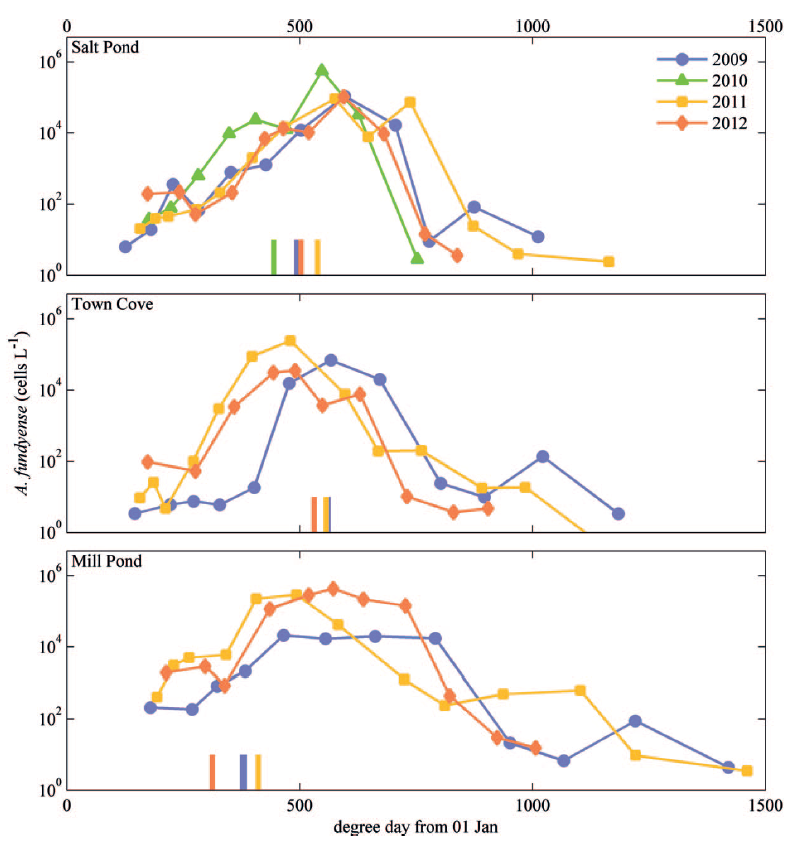Physical-biological interactions
For many organisms in estuaries and coastal that are sessile or swim relatively slowly, environmental conditions such as stratification, turbulence, or other water properties present primary controls on their viability. Working closely with biologists, we are interested in exploring how the physical framework affects biological response. The harmful algae Alexandrium fundyense can cause paralytic shellfish poisoning and has major economic impacts through shellfishing closures. We have been examining how physical processes enhance a recurring estuarine bloom in Nauset estuary on Cape Cod, and used a simple model to show how vertical migration can explain observed distributions in the Gulf of Maine. Other biophysical collaborations have looked at how oyster survival in the Hudson depends on river discharge and may shift with future climate conditions, and on how beach contamination depends on tidally modulated fluxes of groundwater through the sand.
Selected publications
Stratification increases residence time and growth of harmful algal bloom
Ralston, DK, ML Brosnahan, SE Fox, KD Lee, and DM Anderson, 2015. Temperature and residence time controls on an estuarine harmful algal bloom: Modeling hydrodynamics and Alexandrium fundyense in Nauset estuary. Estuaries and Coasts, doi:10.1007/s12237-015-9949-z.
We use a highly resolved, 3-d model to simulate the hydrodynamics and A. fundyense bloom in Nauset estuary on Cape Cod over multiple years. The physical and biological properties in the model were evaluated with quantitative skill metrics by comparison with moored and survey data over a four year period. While the A. fundyense model is based on existing models for the Gulf of Maine bloom, we found that significant modifications were required to represent the Nauset bloom, including earlier cyst germination, greater maximum growth rates, and a different functional form of the mortality term driving bloom termination. Using the model we found that residence times of cells in the three salt ponds of Nauset were long compared with the cell doubling time, allowing the blooms to grow rapidly rather than being flushed to the coastal ocean. Retention in the ponds depended on the vertical migration pattern (cells avoid the surface layer where most of the tidal exchange occurs) and stratification (reduces vertical mixing of cells into the surface layer). The bloom was relatively insensitive to nutrient concentrations due to the eutrophic conditions of the estuary.
Using degree days to predict a harmful algal bloom
Ralston, DK, BA Keafer, ML Brosnahan, and DM Anderson, 2014. Temperature dependence of an estuarine harmful algal bloom: Resolving interannual variability in bloom dynamics using a degree day approach. Limnol. Oceanogr., 59(4):1112-1126, doi:10.4319/lo.2014.59.4.1112.
Nauset Estuary on Cape Cod has a recurrent harmful algal bloom of the dinoflagellate Alexandrium fundyense that leads to nearly annual closure to shellfishing. Major A. fundyense blooms were observed in 4 consecutive years. Max concentrations exceeded 1 million cells/L, and were greatest in three salt ponds at the edges of the estuary. Bloom timing varied among the ponds and among years, and was associated with differences in water temperature. A growing degree-day calculation was used to account interannual variability and spatial gradients in temperature on growth rate and population development, and it collapsed variability in the timing of bloom onset, development, and termination. This relatively simple metric may be useful as an early-warning indicator for HABs in Nauset and similar systems with localized, self-seeding blooms.
Asynchronous vertical migration of dinoflagellates
Ralston, DK, DJ McGillicuddy, and DW Townsend, 2007. Asynchronous vertical migration and bimodal distribution of motile phytoplankton. J. Plankton Res., 29(9), 803-821, doi:10.1093/plankt/fbm061.
Some phytoplankton can exploit deep sources of nutrients with vertical migration: photosynthesis near the surface, transit to depth, nutrient uptake, and back to the surface. If the cycle takes less than 24 h, then it can be synchronized to the day/night cycle. If it takes longer than 24 h, then migration may be asynchronous. Many observations have found bimodal vertical distributions of phytoplankton, with maxima near the surface and the nutricline. We show how bimodal distributions may result from asynchronous vertical migration, modeling the dinoflagellate Alexandrium fundyense in conditions similar to those in the Gulf of Maine. Migration is regulated by internal nutritional state—organisms swim down when depleted of nitrogen, and return to the surface after nutrient uptake. Depending on growth rate, uptake rate and swimming speed, phytoplankton distributions can be bimodal or unimodal.


